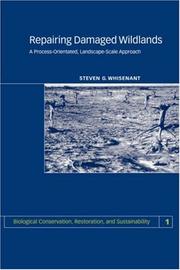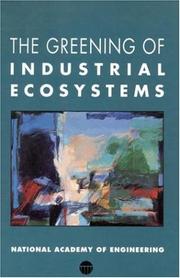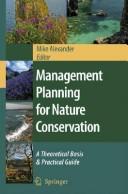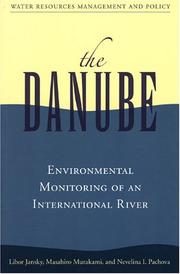| Listing 1 - 9 of 9 |
Sort by
|
Book
Abstract | Keywords | Export | Availability | Bookmark
 Loading...
Loading...Choose an application
- Reference Manager
- EndNote
- RefWorks (Direct export to RefWorks)
Conservation biology is a rapidly evolving discipline, with its historically synthetic, multidisciplinary framework having expanded extensively in recent years. Seemingly disparate disciplines, such as behavior and physiology, are being integrated into this discipline’s growing portfolio, resulting in diverse tools that can help develop conservation solutions. Demonstrations are needed, however, of how behavior and physiology — either separately or combined — have contributed to conservation success. Behavior and physiology have traditionally been considered separate fields; yet, their integration can provide a more comprehensive approach to offering solutions to conservation and management problems. Examining species’ vulnerabilities to extinction through the lenses of behavior and physiology can provide insight into the mechanisms that drive population declines and extirpations. Our goal is to increase awareness of the benefit of combining behavioral and physiological tools to improve conservation management decisions. Such studies can also help strengthen the basis for evidence-based conservation which, in some cases, has been previously lacking.
behavior --- physiology --- conservation management --- environmental stressors --- urbanization
Book
ISBN: 0520976924 Year: 2022 Publisher: Oakland, California : University of California Press : University of Oregon,
Abstract | Keywords | Export | Availability | Bookmark
 Loading...
Loading...Choose an application
- Reference Manager
- EndNote
- RefWorks (Direct export to RefWorks)
The second edition of the award-winning Atlas of Yellowstone contains 50% new material, making it the authoritative reference for the world's first national park on its 150th anniversary. The publication of the Atlas of Yellowstone, Second Edition coincides with the 150th anniversary of the founding of Yellowstone National Park--a major international event. The atlas is an accessible, comprehensive guide that presents Yellowstone's story through compelling visualizations rendered by award-winning cartographers at the University of Oregon. Readers of this new edition of the Atlas of Yellowstone will explore the contributions of Yellowstone to preserving and understanding natural and cultural landscapes, to informing worldwide conservation practices, and to inspiring national parks around the world, while also learning about the many struggles the park faces in carrying out its mission. Ranging from Indigenous Americans and local economies to geysers and wildlife migrations, from the life of one wolf to the threat of wildfires, each page provides leading experts' insights into the complexity and significance of Yellowstone. Key elements of the atlas include: More than 1,000 maps, graphics, and photographs Contributions from more than 130 experts Detailed topographic maps of Yellowstone and Grand Teton National Parks Exploration of Yellowstone National Park's influence over 150 years on conservation practice, park management, and American culture New, detailed visualizations of wildlife that take advantage of modern GPS technology to track individual animals and entire herds Place-name origins for Yellowstone and Grand Teton National Parks and the surrounding region.
Physical geography --- Human geography --- Wildlife refuges --- Yellowstone National Park --- american indian. --- archaeology. --- cartography. --- conservation management. --- ecosystem. --- geography. --- geology. --- geothermal. --- geyser. --- gift. --- grand teton. --- idaho. --- montana. --- mountain ranges. --- natural resources. --- old faithful. --- topography. --- wildlife. --- wyoming. --- yellowstone national park.

ISBN: 052166540X 051101760X 0521470013 0511152523 1280416831 0511612567 0511327560 9786610416837 0511053010 0511173458 1107112478 9780511017605 9780511173455 9780511612565 9780521470018 9780521665407 9780511152528 Year: 1999 Publisher: Cambridge Cambridge university press
Abstract | Keywords | Export | Availability | Bookmark
 Loading...
Loading...Choose an application
- Reference Manager
- EndNote
- RefWorks (Direct export to RefWorks)
The interesting approach to ecological restoration described in this book will appeal to anyone interested in improving the ecological conditions, biological diversity, or productivity of damaged wildlands. Using sound ecological principles, the author describes how these ecosystems are stabilised and directed toward realistic management objectives using natural recovery processes rather than expensive subsidies. An initial emphasis on repairing water and nutrient cycles, and increasing energy capture, will initiate and direct positive feedback repair systems that drive continuing autogenic recovery. This strategy is most appropriate where landuse goals call for low-input, sustainable vegetation managed for biological diversity, livestock production, timber production, wildlife habitat, watershed management, or ecosystem services. Providing a comprehensive strategy for the ecological restoration of any wildland ecosystem, this is an invaluable resource for professionals working in the fields of ecological restoration, conservation biology and rangeland management.
Restoration ecology. --- Earth & Environmental Sciences --- Ecology --- Restoration ecology --- Conservation biology --- Range management --- 502.37 --- 502.35 --- Rangeland management --- Rangelands --- Ecosystem management --- Natural resources --- Ranching --- Nature conservation --- Ecological restoration --- Ecosystem restoration --- Rehabilitation ecology --- Restoration of ecosystems --- Applied ecology --- Restoration, salvage, rescue measures. Sanitation --- Conservation management in general. Monitoring --- Management --- Life Sciences --- General and Others --- 502.35 Conservation management in general. Monitoring --- 502.37 Restoration, salvage, rescue measures. Sanitation --- Conservation biology. --- Range management.

ISBN: 0309049377 9786610211371 1280211377 0309585805 0585158770 9780585158778 9781280211379 661021137X 9780309585804 9780309049375 Year: 1994 Publisher: Washington, D.C. National Academy Press
Abstract | Keywords | Export | Availability | Bookmark
 Loading...
Loading...Choose an application
- Reference Manager
- EndNote
- RefWorks (Direct export to RefWorks)
Environmental sciences --- Factory and trade waste --- Environmental policy --- Conservation of natural resources --- Earth & Environmental Sciences --- Environmental Sciences --- 502.35 --- 502.36 --- 504.064.4 --- Conservation of resources --- Natural resources --- Natural resources conservation --- Resources conservation, Natural --- Environmental protection --- Natural resources conservation areas --- Environment and state --- Environmental control --- Environmental management --- Environmental quality --- State and environment --- Environmental auditing --- Factory waste --- Industrial effluents --- Industrial wastes --- Solid waste management --- Trades-waste --- Wastewaters --- Plant engineering --- Centralized industrial waste treatment facilities --- Pollution --- Refuse and refuse disposal --- Waste products --- Environmental science --- Science --- Conservation management in general. Monitoring --- Scientific and technical conservation measures. Environmental engineering --- Measures in conservation engineering. Including: wasteless and low-waste technology --- Conservation --- Government policy --- 504.064.4 Measures in conservation engineering. Including: wasteless and low-waste technology --- 502.36 Scientific and technical conservation measures. Environmental engineering --- 502.35 Conservation management in general. Monitoring --- Environmental sciences. --- Factory and trade waste. --- Environmental policy. --- Conservation of natural resources.

ISBN: 9781402065804 1402065809 1402065817 Year: 2008 Publisher: Dordrecht : Springer Netherlands : Imprint: Springer,
Abstract | Keywords | Export | Availability | Bookmark
 Loading...
Loading...Choose an application
- Reference Manager
- EndNote
- RefWorks (Direct export to RefWorks)
Mike Alexander’s Management Planning for Nature Conservation brings a new dimension to the modern literature on conservation management. Combining key theories with real practice it fills a critical gap which has often hindered in-depth understanding of the planning process. The book provides historical and rational background which helps to explain what makes a really effective management plan, and it presents a detailed practical guide to developing such a plan. It concludes with a series of case studies which clearly illustrate the underlying principles drawn out in the text, while highlighting the different approaches demanded by very different sites. Drawing on the expertise of leaders in both conservation research and wildlife management, and with a combined experience from around the world, this book is essential reading for professional conservation managers and any student studying management planning for conservation within a range of degree and postgraduate courses. The book will be equally important for those attending professional training programmes and courses for practitioners in the statutory and voluntary environment and wildlife conservation sector. Mike Alexander has been at the forefront of developing systems and methods in the field of management planning for conservation, with experience ranging from Uganda to Estonia, and from Costa Rica to Wales. He was a member of the team responsible for developing the current management planning guidelines for the international Ramsar (Convention on Wetlands) sites located around the world.
Nature protection --- General ecology and biosociology --- Environmental protection. Environmental technology --- Nature conservation --- Nature --- Planning. --- Management. --- Conservation --- Planification --- Gestion --- Electronic books. -- local. --- Nature conservation -- Management. --- Nature conservation -- Planning. --- Environmental Sciences --- Ecology --- Earth & Environmental Sciences --- Planning --- Management --- Ressource naturelle --- Natural resources --- Conservation des ressources --- Resource conservation --- Gestion des ressources --- resource management --- EPUB-LIV-FT LIVECOLO SPRINGER-B --- Conservation of nature --- Protection of nature --- Environment. --- Applied ecology. --- Environmental management. --- Nature conservation. --- Environmental Management. --- Nature Conservation. --- Applied Ecology. --- Conservation of natural resources --- Applied ecology --- Conservation biology --- Endangered ecosystems --- Natural areas --- Environmental protection --- Environmental stewardship --- Stewardship, Environmental --- Environmental sciences
Book
Year: 2022 Publisher: Basel MDPI - Multidisciplinary Digital Publishing Institute
Abstract | Keywords | Export | Availability | Bookmark
 Loading...
Loading...Choose an application
- Reference Manager
- EndNote
- RefWorks (Direct export to RefWorks)
This book focuses on conservation genetic (and genomic) papers that demonstrate applied outcomes that inform practical threatened species management. We cover a broad range of species and genetic approaches, but focus on how conservation genetic information is used to underpin management actions for species recovery. Through the exposition of a diversity of approaches, we aim to demonstrate to conservation managers and researchers how conservation genetics can inform on-ground species management.
small isolated population --- Mediterranean native trout --- morphological deformities --- Camphorosmoideae --- conservation genetics --- disjunct distribution --- population fragmentation --- population structure --- single nucleotide polymorphism (SNP) markers --- genetic diversity --- population viability analysis --- allele retention --- translocation --- conservation management --- threatened marsupial --- remnant --- conservation --- natural hybridisation --- Eucalyptus --- high throughput sequencing --- NGS --- South Australia --- golden bandicoot --- southern brown bandicoot --- quenda --- phylogenetic --- taxonomy --- evolutionarily significant unit --- ecosystem engineer --- genetic rescue --- genetic restoration --- supplementation --- disease --- inbreeding --- genetic swamping --- locally unique alleles --- population genetics --- marsupial --- adaptive potential --- Leadbeater’s possum --- Gymnobelideus leadbeateri --- ex situ conservation --- Psittacidae --- Ara macao --- Xcaret --- captive breeding --- climate drying --- cpDNA --- ecotype --- Evolutionarily Significant Units --- gene flow --- geographic expansion --- patchy abundance --- phylogeography --- n/a --- Leadbeater's possum

ISBN: 9280810618 9280870653 141756413X 9781417564132 9789280810615 9789280870657 Year: 2004 Publisher: Tokyo United Nations university press
Abstract | Keywords | Export | Availability | Bookmark
 Loading...
Loading...Choose an application
- Reference Manager
- EndNote
- RefWorks (Direct export to RefWorks)
The Danube river is one of the world's greatest international freshwater resources. It stretches halfway across Europe and passes through 11 countries. Its catchment is shared by 17 nations, many of whom are new members of the expanded European Union.This book focuses on the disputed Gabcíkovo-Nagymaros Project on the Danube between Hungary and the Slovak Republic. It examines the history and progress of the case from the International Court of Justice to the subsequent agreement to joint monitoring and assessment of the environmental implications. It uses a multidisciplinary methodology combi
Environmental monitoring -- Danube river region. --- Environmental monitoring. --- Water resources development -- Environmental aspects -- Danube river region. --- Water resources development -- Political aspects -- Danube river region. --- Water resources development --- Environmental monitoring --- Business & Economics --- Agricultural Economics --- Political aspects --- Environmental aspects --- 504.45 --- 502.35 --- 556.51 <282.243.7> --- Biomonitoring (Ecology) --- Ecological monitoring --- Environmental quality --- Monitoring, Environmental --- Applied ecology --- Environmental engineering --- Pollution --- Energy development --- Natural resources --- Water-supply --- Running water environment. Inland surface waters. Rivers, river mouths, deltas, lakes, swamps, wetlands --- Conservation management in general. Monitoring --- Drainage basins. Catchment areas. River basins. Watersheds--Donau --- Measurement --- Monitoring --- Gabcikovo-Nagymaros Project --- Bős (Gabčíkovo)-Nagymaros Danube Barrage System Project --- Bős (Gabčíkovo)-Nagymarosi Vízlépcsőrendszer (Project) --- Bős-Nagymaros (Project) --- Bős-Nagymaros Water Barrage System (Project) --- Bős-Nagymarosi Vízlépcső (Project) --- Gabčíkovo (Bős)-Nagymaros Barrage System (Project) --- Gabčíkovo-Nagymaros Barrage System (Project) --- Gabčíkovo-Nagymaros Hydropower Project --- Gabčíkovo-Nagymarosi Vízlépcsőrendszer (Project) --- Sústava vodných diel Gabčíkovo-Nagymaroš --- 556.51 <282.243.7> Drainage basins. Catchment areas. River basins. Watersheds--Donau --- 502.35 Conservation management in general. Monitoring --- 504.45 Running water environment. Inland surface waters. Rivers, river mouths, deltas, lakes, swamps, wetlands --- Gabčíkovo-Nagymaros Project.
Book
ISBN: 9789020976465 9789020970487 9020965123 9020959182 9020954407 9044113543 9044111957 9053508708 9053507264 9789020965124 9789053507261 Year: 2005 Publisher: Leuven Lannoo Campus
Abstract | Keywords | Export | Availability | Bookmark
 Loading...
Loading...Choose an application
- Reference Manager
- EndNote
- RefWorks (Direct export to RefWorks)
Dit is het tweede MIRA-T jaarboek. Verder bouwend op het vorige jaarboek, geeft dit boek de evolutie van de indicatoren weer en verschaft informatie over recente milieuontwikkelingen. Waar mogelijk werd het verloop van de indicatoren getoetst aan normen en doelstellingen en het verband met het beleid aangeduid. Het Milieu- en natuurrapport Vlaanderen: thema's toont aan dat het milieu geleidelijk verbetert maar dat grote problemen blijven bestaan. Zo bevinden wij ons bijvoorbeeld nog zeer ver van hetbehalen van de meest recente doelstellingen om verzuring, vermesting en waterverontreiniging tot een duurzaam niveau terug te brengen. De chemische belasting van het milieu en de mens door producten van onvolledige verbranding, zwevend stof , fotochemische smog en bestrijdingsmiddelen blijft hoog, vaakhoger dan in de ons omringende landen. Ook zijn er nog steeds geen concrete maatregelen om de uitstoot van broeikasgassen teverminderen. Voor de meeste thema's is de economische groei nog niet losgekoppeld van een gelijktijdige groei in de milieubelasting. De uitdaging blijft dus bestaan om de weg naar duurzame ontwikkeling resoluut en definitief in te slaan. Ieder hoofdstuk in dit jaarboek laat zich afzonderlijk lezen en wordt onderbouwd door achtergronddocumenten die op het internet beschikbaar zijn. Dit jaarboek, samen met de vorige MIRA-rapporten, geeft de 'state-of-the-art' van de beschikbaremilieukennis in Vlaanderen. Dit is het tweede Mira-T jaarboek, de barometer van de milieukwaliteit in Vlaanderen. 21 milieuverstoringsprocessen of thema's worden beschreven azan de hand van indicatoren. Mira-T 1999 bouwt verder op het vorige jaarboek, geeft de evolutie van de indicatoren weer en verschaft informatie over recente milieuontwikkelingen. (Bron: covertekst)
614.7 --- P493VL --- 54<493-17> --- Vlaanderen --- milieubeleid --- milieurapport --- biodiversiteit --- bodemverontreiniging --- eco-efficiëntie --- emissiepreventie --- energieverbruik --- jaaroverzicht --- oppervlaktewater --- radioactief afval --- verkeersorganisatie (verkeersmanagement) --- vlaams milieubeleid --- waterhuishouding --- wegvervoer --- milieu - leefmilieu - milieubeleid (zie ook 712) - duurzame ontwikkeling --- (zie ook: verontreinigde grond) --- Annual reports --- 504 --- #SBIB:35H434 --- #SBIB:35H6015 --- 500 Milieu --- 504 Environment. Environmental science --- Environment. Environmental science --- Beleidssectoren: milieubeleid en ruimtelijke ordening --- Bestuur en beleid: nationale en regionale studies: Vlaanderen --- milieu - leefmilieu - milieubeleid (zie ook 712) --- 614.7 <493> --- 502.3 --- 351.777 <493-17> --- #WSCH:AAS1 --- #A9803A --- Leefmilieu --- Natuur (behoud) --- Vlaamse Gemeenschap / Gewest --- broeikaseffect --- geluidhinder --- milieuproblematiek --- milieuvervuiling --- waterzuivering --- 614.61 --- afvalverwerking --- energie --- geluidshinder --- luchtverontreiniging --- milieuhygiëne --- verkeer --- waterverontreiniging --- Milieubeleid: Vlaanderen --- Milieurapporten: Vlaanderen --- milieu: Vlaanderen --- 502.3 Nature and society. Nature conservation and protection in general --- Nature and society. Nature conservation and protection in general --- 351.777 <493-17> Wetgeving, reglementering i.v.m. milieubeheer, milieuhygiene, verontreiniging. Milieurecht. Milieuhygienerecht--zie ook {?502/504}; {?613/614}; {628}--Vlaanderen. Vlaams Gewest. Nederlandstalige Gemeenschap in België --- Wetgeving, reglementering i.v.m. milieubeheer, milieuhygiene, verontreiniging. Milieurecht. Milieuhygienerecht--zie ook {?502/504}; {?613/614}; {628}--Vlaanderen. Vlaams Gewest. Nederlandstalige Gemeenschap in België --- Pollutie van lucht, water, grond--(openbare gezondheidszorg)--België --- Environnement --- Nature (Préservation de la) --- jaarverslagen --- Milieu 504.7 --- Milieubeleid 504.7:338 --- Ministerie van de Vlaamse Gemeenschap 353.11 --- economische indicatoren --- statistiek --- milieutechnologie --- radioactiviteit --- genetische manipulatie --- vervoer --- consumentisme --- Milieu --- Milieubeleid --- Nature conservation --- Flanders (Belgium) --- Congresses --- Environmental protection --- 504 <493-17> --- #A0308A --- PCB --- afvalstoffen --- klimaatverandering --- lawaai --- lichthinder --- milieu --- stralingen --- zware metalen --- 504 <493-17> Environment. Environmental science--Vlaanderen. Vlaams Gewest. Nederlandstalige Gemeenschap in België --- Environment. Environmental science--Vlaanderen. Vlaams Gewest. Nederlandstalige Gemeenschap in België --- 502.35 --- 504.7 --- #A9910A --- Afval --- Bestrijdingsmiddelen --- Broeikaseffect --- Lawaai --- Licht --- Mest --- Oppervlaktewater --- Ozonlaag --- Stank --- Zware metalen --- D50178.jpg --- Milieubeleid ; Vlaanderen --- 502.35 Conservation management in general. Monitoring --- Conservation management in general. Monitoring --- Pollutie van lucht, water, grond--(openbare gezondheidszorg) --- Milieubeleid; algemeen - Milieurecht; algemeen --- Environmental law --- Environmental protection. Environmental technology --- Flanders --- 504:35 --- leefmilieu --- milieu-effectrapporten --- natuurbeleid --- 614.6 --- Milieu . Vlaanderen --- 628 --- Milieuproblematiek (Milieuvervuiling, Milieuzorg) --- Beleidsdocumenten: Vlaanderen. --- Nature --- Environnement. --- Environmental Sciences and Forestry. Environmental Management --- Environmental Policy. --- Environmental Management (General). --- #A0401A --- België --- natuur --- E04049.jpg --- Milieu ; Vlaanderen --- milieubeleid, milieurecht
Book
ISBN: 3039211943 3039211935 Year: 2019 Publisher: MDPI - Multidisciplinary Digital Publishing Institute
Abstract | Keywords | Export | Availability | Bookmark
 Loading...
Loading...Choose an application
- Reference Manager
- EndNote
- RefWorks (Direct export to RefWorks)
This book collects 15 papers written by renowned scholars from across the globe that showcase the forefront research in Earth observation (EO), remote sensing (RS), and geoscientific ground investigations to study archaeological records and cultural heritage.Archaeologists, anthropologists, geographers, remote sensing, and archaeometry experts share their methodologies relying on a wealth of techniques and data including, but not limited to: very high resolution satellite images from optical and radar space-borne sensors, air-borne surveys, geographic information systems (GIS), archaeological fieldwork, and historical maps.A couple of the contributions highlight the value of noninvasive and nondestructive laboratory analyses (e.g., neutron diffraction) to reconstruct ancient manufacturing technologies, and of geological ground investigations to corroborate hypotheses of historical events that shaped cultural landscapes.Case studies encompass famous UNESCO World Heritage Sites (e.g., the Nasca Lines in Peru), remote and yet-to-discover archaeological areas in tropical forests in central America, European countries, south Asian changing landscapes, and environments which are arid nowadays but were probably full of woody vegetation in the past.Finally, the reader can learn about the state-of-the-art of education initiatives to train site managers in the use of space technologies in support of their activities, and can understand the legal aspects involved in the application of EO and RS to address current challenges of African heritage preservation.
settlements --- historical landscapes --- floods --- landscape archaeology --- education --- archaeological fieldwork --- Burial Mound --- geoglyph Pista --- OBIA --- satellite imagery --- multi-criteria --- airborne LiDAR --- international law --- Survey of India --- mapping --- Landscape --- Africa --- heritage --- Belize --- relict boundaries --- capacity development --- synthetic aperture radar --- disaster and conservation management --- Motte-and-Bailey castle --- neutron techniques --- Cuenca Pisco --- grain-size --- geological mapping --- Peru --- Visualization --- drones --- volcaniclastic layer --- UAV --- Harra --- stratigraphy --- Archaeology --- e-learning --- field reconnaissance --- neutron diffraction --- archaeological prospection --- Jordan --- Mesoamerica --- predictive model --- Ridge and Furrow --- Mega El Niño --- Earth Observation --- archaeological landscapes --- colonial studies --- river morphology --- pampa of Nazca --- optical --- Boundary Demarcation --- space law --- orthophotographs --- Oman --- GoogleEarth --- archaeometry --- Cameroon-Nigeria Mixed Commission --- national archaeological mapping programme --- Maya --- Sacred --- subsurface imaging --- basalt desert --- Indus --- archaeological survey --- Sentinel-2 --- surface survey --- Ritual --- remote sensing --- microwave penetration --- Difference Map --- drone --- tumuli --- GIS --- international boundaries --- Lidar --- Caves --- Archaeological Survey of India --- chemometric analysis --- UNESCO --- Rio Grande de Nazca --- SAR --- photogrammetry --- Earth observation --- arid environments --- Sumerian pottery --- cultural and natural heritage --- free satellite imagery --- field monument --- RPAS --- archaeology --- historical maps --- satellite --- petrography --- automated detection --- pattern recognition --- Arran --- LiDAR --- airborne laser scanning --- landscape accessibility --- Geographic Information System (GIS) --- Bing Maps --- analytic hierarchy process (AHP) --- Roman archaeology --- Saharan Morocco
| Listing 1 - 9 of 9 |
Sort by
|

 Search
Search Feedback
Feedback About UniCat
About UniCat  Help
Help News
News